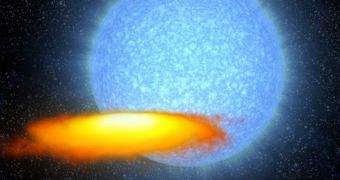For many years, astrophysicists have had a hard time explaining why a binary star system located in the galaxy Messier 33 exists. The system is formed from a massive star, which is orbited by a large black hole.
Generally, if black holes exist in binary systems, they tend to have a maximum mass of about 10 Suns, but this particular one tips the scale at 15.7 solar masses.
Its companion star is even larger, boasting a weight of about 70 times that of our parent star. The black hole orbits its companion once every 3.45 days. The system is located some 2.7 million light-years away from Earth.
The new investigation also proposes a novel mechanism for the formation of the black hole M33 X-7. What was so mysterious about it until now is that its existence disproved long-standing theories about black holes.
Other binary systems of this nature contain smaller black holes as a rule, and the bodies form when the star begins to exhaust its supply of hydrogen fuel. When this happens, it reaches the end of its burning cycle.
But experts propose that M33 X-7 is different, in the sense that the structure appeared precisely because its parent star still had plenty hydrogen gas reserves to burn and convert into helium.
Systems such as this one are usually observed using X-ray telescopes, because the black holes within emit a lot of radiation in this portion of the electromagnetic spectrum, Space reports.
Using existing models of binary X-ray systems, experts were unable to develop a pertinent explanation as to why M33 X-7 exists in its current configuration.
“This massive black hole is orbiting the most massive star ever discovered in this class of systems, and the orbit is very tight compared to the size of the star,” explains Francesca Valsecchi.
The expert, who was the leader of the new investigation, who is a PhD student at the Northwestern University. Details of the work appear in the October 20 issue of the esteemed journal Nature.
“It is encouraging to have confirmation of our basic understanding of binary evolution and black hole formation, as it allows us to trust our physical models and make predictions for other black hole systems that are yet to be discovered,” she adds.
The model developed at the university shows that, most likely, the large black hole originated in a star that weighed as much as 100 Sun masses, which spun around a parent star some 30 Sun masses in weight.
Due to complex interactions between the two, the larger star eventually collapsed to form the current black hole, and began consuming matter from its companion.

 14 DAY TRIAL //
14 DAY TRIAL //